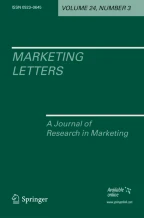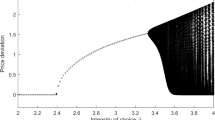Modeling social interactions: Identification, empirical methods and policy implications

Social interactions occur when agents in a network affect other agents’ choices directly, as opposed to via the intermediation of markets. The study of such interactions and the resultant outcomes has long been an area of interest across a wide variety of social sciences. With the advent of electronic media that facilitate and record such interactions, this interest has grown sharply in the business world as well. In this paper, we provide a brief summary of what is known so far, discuss the main challenges for researchers interested in this area, and provide a common vocabulary that will hopefully engender future (cross disciplinary) research. The paper considers the challenges of distinguishing actual causal social interactions from other phenomena that may lead to a false inference of causality. Further, we distinguish between two broadly defined types of social interactions that relate to how strongly interactions spread through a network. We also provide a very selective review of how insights from other disciplines can improve and inform modeling choices. Finally, we discuss how models of social interaction can be used to provide guidelines for marketing policy and conclude with thoughts on future research directions.
This is a preview of subscription content, log in via an institution to check access.
Access this article
Subscribe and save
Springer+ Basic
€32.70 /Month
- Get 10 units per month
- Download Article/Chapter or eBook
- 1 Unit = 1 Article or 1 Chapter
- Cancel anytime
Buy Now
Price includes VAT (France)
Instant access to the full article PDF.
Rent this article via DeepDyve
Similar content being viewed by others

Forward Look at Research Perspectives
Chapter © 2013

Social Network Analysis and the Sociology of Economics: Filling a Blind Spot with the Idea of Social Embeddedness
Chapter © 2021

Communication, networks and asset price dynamics: a survey
Article Open access 18 October 2023
Explore related subjects
Notes
Manski (2000) refers to the presence of γ in both interacting agents equations as an endogenous social effect and μ as an exogenous social effect.
We do not index the parameters θ, λ, and δ by the indices i and j for expositional simplicity; but conceptually, these parameters can be individual-specific.
We could generalize further without any change in the substantive implications of our argument, that only the expected action of j drives i’s decision to send WOM: e.g. \(\beginc> \\ \\ \end \)
This may be the case because decision making in the group is known a priori to be sequential or because the analyst formulates the problem in continuous time with infinitely small time increments. As Doraszelski and Judd (2007) point out, a continuous-time model does not have simultaneity because only one agent can act at an instantaneous point in time.
An alternative exclusion restriction imposes a temporal ordering, i.e., the focal individual’s behavior in time (t + 1) is affected by the group behavior up to time (t; see Manchanda et al. 2004 for an example). However, a caveat to this identification strategy is that unobservables should not be correlated over time, and agents must be assumed not to be forward looking (i.e., agents are passive).
Further, as noted by Glaeser et al. (2003), in the presence of social interactions at the individual-level, models estimated on aggregate data are liable to be subject to large aggregation biases that inflate the extent of individual-level social interactions. Hence, “q coefficient-s” in a Bass model are less suited for an interpretation as causal measures of social contagion and are more appropriately interpreted as descriptive parameters capturing the dependence of current aggregate sales on the past-installed base of the product.
We use the term possessed carefully because, unlike financial or physical capital, status is a form of social capital and, therefore, owned only in part by the individual or organization, whose audience—capable of withdrawing at any time the esteem and recognition on which status rests—also acts as a part owner (cf. Burt 1987)
References
- Ackerberg, D., & Gowrisankaran, G. (2006). Quantifying equilibrium network externalities in the ach banking industry. NBER working paper 12488. Cambridge: NBER. Google Scholar
- American Marketing Association. (2007). Social network ad spending up. Accessed at http://www.marketingpower.com/content142914.php
- Anselin, L. (2001). Spatial econometrics. In B. Baltagi (Ed.), A Companion to Theoretical Econometrics (pp. 310–330). Oxford: Blackwell. Google Scholar
- Bajari, P., Benkard, L., & Levin, J. (2007). Estimating dynamic models of imperfect competition. Econometrica, 75(5), 1331–1370. ArticleGoogle Scholar
- Bajari, P., Hong, H., & Ryan, S. (2006a). Identification and Estimation of a Discrete Game of Complete Information. working paper. Minneapolis: University of Minnesota. Google Scholar
- Bajari, P., Hong, H., Krainer, J., & Nekipelov, D. (2006b). Estimating Static Models of Strategic Interactions. working paper. Minneapolis: University of Minnesota. Google Scholar
- Bala, V., & Goyal, S. (2000). A non-cooperative model of network formation. Econometrica, 68, 1181–1229. ArticleGoogle Scholar
- Bell, D., & Song, S. (2007). Neighborhood effects and trial on the internet: evidence from online grocery retailing. Quantitative Marketing and Economics, 5(4), 361–400. ArticleGoogle Scholar
- Bothner, M. S., Kim, Y. K., & Lee, W. (2006). Primary Status, Complementary Status, and Capital Acquisition in the US Venture Capital Industry. Working Paper. Chicago: University of Chicago. Google Scholar
- Bresnahan, T., & Reiss, P. (1991). Empirical models of discrete games. Journal of Econometrics, 48, 57–81. ArticleGoogle Scholar
- Brock, W. A., & Durlauf, S. N. (2001). Discrete choice with social interactions. Review of Economic Studies, 68(235), 235–260, (April). ArticleGoogle Scholar
- Burt, R. S. (1987). Social contagion and innovation: cohesion versus structural equivalence. American Journal of Sociology, 92, 1287–1335, (May). ArticleGoogle Scholar
- Coleman, J. S., Elihu, K., & Menzel, H. (1966). Medical Innovation. New York: Bobbs-Merrill. Google Scholar
- Conley, T., & Udry, C. (2003). Learning About a New Technology: Pineapple in Ghana. Working Paper. Chicago: University of Chicago. Google Scholar
- Dodds, P. S., & Watts, D. J. (2004). Universal behavior in a generalized model of contagion. Physical Review Letters, 92, 218701–218705. ArticleGoogle Scholar
- Dodds, P. S., & Watts, D. J. (2005). A generalized model of social and biological contagion. Journal of Theoretical Biology, 232, 587–604. ArticleGoogle Scholar
- Doraszelski, U., & Judd, K. (2007). Avoiding the curse of dimensionality in dynamic stochastic games, working paper. Stanford: Hoover Institution. Google Scholar
- Draganska, M., et al. (2008). Discrete choice models of firms’ strategic decisions. Marketing Letters, in press.
- Dubé, J. P., Günter, J. H., & Chintagunta, P. (2007). Dynamic standards competition and tipping: The case of 32/64Bit Video Game Consoles, working paper. Chicago: University of Chicago. Google Scholar
- Duflo, E., & Saez, E. (2003). The role of information and social interactions in retirement plan decisions: evidence from a randomized experiment. Quarterly Journal of Economics, 118(3), 815–842. ArticleGoogle Scholar
- Durrett, R. (1999). Stochastic spatial models. SIAM Review, 41, 677–718. ArticleGoogle Scholar
- Economides, N., & Himmelberg, C. (1995). Critical mass and network size with application to the US fax market, working paper. New York: New York University. Google Scholar
- Fleder, D. M., & Hosanagar, K. (2007). Blockbuster culture’s next rise or fall: the impact of recommender systems on sales diversity, working paper. Philadelphia: University of Pennsylvania. Google Scholar
- Gladwell, M. (2000). The tipping point: how little things can make a big difference. Lancaster: Little Brown.
- Glaeser, E., & Scheinkman, J. (2001). Measuring social interactions. In S. Durlauf, & P. Young (Eds.), Social dynamics. Cambridge: MIT. Google Scholar
- Glaeser, E. L., Sacerdote, B. I., & Scheinkman, J. A. (2003). The social multiplier.. Journal of the European Economic Association, 1(2, 3), 345–353. ArticleGoogle Scholar
- Godes, D., & Mayzlin, D. (2004). Firm-created word-of-mouth communication: a field-based quasi-experiment. HBS Marketing Research Paper No. 04-03. Available at SSRN: http://ssrn.com/abstract=569361.
- Granovetter, M. (1973). The strength of weak ties. American Journal of Sociology, 78, 1360–1380, (May). ArticleGoogle Scholar
- Granovetter, M. (1978). Threshold models of collective behavior. American Journal of Sociology, 83(6), 1420–1443. ArticleGoogle Scholar
- Hartmann, W. (2008). Demand estimation with social interactions and the implications for targeted marketing, working paper. Stanford: Stanford University. Google Scholar
- Katz, L., Kling, A., & Liebman, J. (2001). Moving to opportunity in Boston: early results of a randomized mobility experiment. Quarterly Journal of Economics, CXVI, 607–654. ArticleGoogle Scholar
- Lee, L. F. (1982). Some approaches to the correction of selectivity bias. The Review of Economic Studies, XLIX, 355–372. ArticleGoogle Scholar
- Manchanda, P., Xie, Y., & Youn, N. (2004). The role of targeted communication and contagion in new product adoption, working paper. Chicago: University of Chicago. Google Scholar
- Manski, C. F. (1993). Identification of endogenous social effects: the reflection problem. Review of Economic Studies, 60, 531–542. ArticleGoogle Scholar
- Manski, C. F. (2000). Economic analysis of social interactions. Journal of Economic Perspectives, 14(3), 115–136. ArticleGoogle Scholar
- Merton, R. K. (1968). The Matthew effect in science. Science, 159(3810), 56–63, (January 5). ArticleGoogle Scholar
- Moffitt, R. (2001). Policy interventions, low-level equilibria, and social interactions. In S. Durlauf, & P. Young (Eds.), Social Dynamics (pp. 45–82). Washington, D. C.: Brookings Institution Press and MIT. Google Scholar
- Nair, H., Manchanda, P., & Bhatia, T. (2006). Asymmetric peer effects in prescription behavior: the role of opinion leaders, working paper. Stanford: Stanford University. Google Scholar
- Nam, S., Manchanda, P., & Pradeep, K. C. (2006). The effects of service quality and word-of-mouth on customer acquisition, retention and usage, working paper. Chicago: University of Chicago. Google Scholar
- Narayan, V., & Yang, S. (2006). Trust between consumers in online communities: modeling the formation of dyadic relationships, working paper. New York: New York University. Google Scholar
- Podolny, J. (2005). Status signals: a sociological study of market competition. Princeton: Princeton University Press. Google Scholar
- Ryan, S., & Tucker, C. (2006). Heterogeneity and the dynamics of technology adoption, working paper. Cambridge: MIT. Google Scholar
- Sacerdote, B. (2001). Peer effects with random assignment: results for Dartmouth roommates. Quarterly Journal of Economics, 116, 681–704, (2 May). ArticleGoogle Scholar
- Salganik, M. J., Dodds, P. S., & Watts, D. J. (2006). An experimental study of inequality and unpredictability in an artificial cultural market. Science, 311, 854–856. ArticleGoogle Scholar
- Schelling, T. (1971). Dynamic models of segregation. Journal of Mathematical Sociology, 1, 143–186. Google Scholar
- Trusov, M. (2006). Your agents are also your customers: marketing for internet social networks, working paper. Baltimore: University of Maryland. Google Scholar
- Tucker, C. (2006). Interactive, option-value and domino network effects in technology adoption, working paper. Cambridge: MIT. Google Scholar
- Van Den, B. C., & Wuyts, S. (2007). Social networks and marketing. Cambridge: Marketing Science Institute. Google Scholar
- Watts, D. J. (2002). A simple model of global cascades on random networks. Proceedings of the National Academy of Sciences, 99, 5766–5571. ArticleGoogle Scholar
- Watts, D. J., et al. (2005). Multiscale, resurgent epidemics in a hierarchical metapopulation model. Proceedings of the National Academy of Sciences, 102(32), 11157–11162. ArticleGoogle Scholar
- Yang, S., & Allenby, G. M. (2003). Modeling interdependent consumer preferences. Journal of Marketing Research, 40(3), 282–294. ArticleGoogle Scholar
- Yang, S., Narayan, V., & Assael, H. (2006). Estimating the interdependence of television program viewership between spouses: a bayesian simultaneous equation model. Marketing Science, 3, 336–349. ArticleGoogle Scholar
Author information
Authors and Affiliations
- Stanford University, Stanford, CA, USA Wesley R. Hartmann & Harikesh Nair
- University of Michigan, Ann Arbor, MI, USA Puneet Manchanda
- University of Chicago, Chicago, IL, USA Matthew Bothner
- University of Vermont, Burlington, VT, USA Peter Dodds
- Harvard University, Cambridge, MA, USA David Godes
- University of Pennsylvania, Philadelphia, PA, USA Kartik Hosanagar
- MIT, Cambridge, MA, USA Catherine Tucker
- Wesley R. Hartmann


